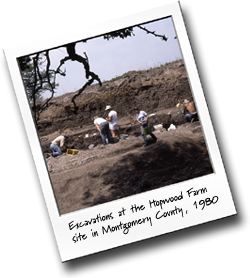 Piecing Together the Past - Hopwood Farm
Piecing Together the Past - Hopwood Farm

Click on active spot to see mastodont footprints.
We know about this environment because our scientists recovered plant and animal fossils from a stream bank at the Hopwood Farm site. About 124,000 years ago, the Hopwood farm was the site of a kettle lake formed in a depression left by a melting block of glacial ice. Plant and animal remains settled to the bottom of the lake and were preserved in the sediment. As sediment accumulated in the lake, fossils continued to be deposited. The site later became a grassland and then a farm field. It was discovered when a stream cut through the ancient lake deposits, and someone noticed bones eroding out of the bank.
In addition to the tortoise, remains from other reptiles, amphibians, fish, birds, and mollusks, were excavated, along with the bones of giant beaver (Castoroides ohioensis), beaver (Castor canadensis), muskrat (Ondatra zibethicus) and raccoon (Procyon lotor). Footprints of a mastodon were also found.